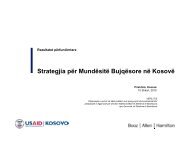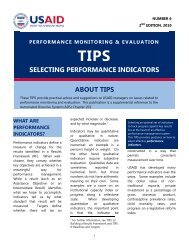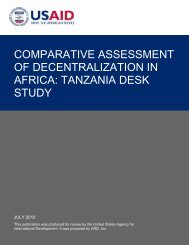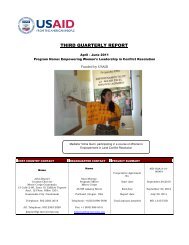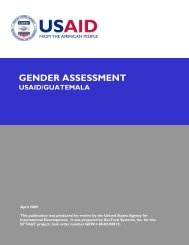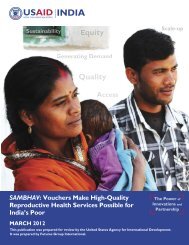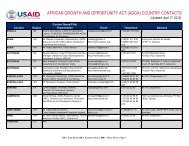Users Guide to USAID/Washington Health Programs
Users Guide to USAID/Washington Health Programs
Users Guide to USAID/Washington Health Programs
Create successful ePaper yourself
Turn your PDF publications into a flip-book with our unique Google optimized e-Paper software.
Introduction <strong>to</strong> <strong>USAID</strong><br />
GHI, the United States strives <strong>to</strong> coordinate its health programming across the whole of government,<br />
other donors, and country partners. It is expected that, where possible, country-owned health delivery<br />
platforms will be the basis for providing comprehensive health services.<br />
• Promoting learning and accountability through moni<strong>to</strong>ring and evaluation: Moni<strong>to</strong>ring and evaluating<br />
our progress, encouraging innovation, using current research, supporting and conducting new research<br />
and sharing the results of our learning are integral <strong>to</strong> all aspects of GHI and critical <strong>to</strong> its success.<br />
Consistent with the U.S. commitment <strong>to</strong> the aid effectiveness principles of country ownership, partnership,<br />
and mutual accountability, we are coordinating our learning and aligning our efforts with those of<br />
our country and development partners. This will include utilizing globally agreed-upon indica<strong>to</strong>rs and<br />
country indica<strong>to</strong>rs when possible. We are committed <strong>to</strong> meaningful and timely evaluation and research<br />
that will inform partner countries, the U.S., and other partners about what works and what does not and<br />
which approaches should be scaled up, modified or phased out.<br />
• Accelerating results through research and innovation: Research has built the evidence base which<br />
underpins key interventions for the GHI, such as the use of Vitamin A <strong>to</strong> reduce child mortality, simplified<br />
antiretroviral treatment, male circumcision for prevention of HIV, community-based treatment of<br />
pneumonia, and use of insecticide-treated bed nets. Evolving disease threats, such as increased drug<br />
resistance, make it difficult <strong>to</strong> rely on the existing body of scientific evidence and technologies alone.<br />
Under GHI, research will continue <strong>to</strong> spur innovation for the discovery and development of new biomedical<br />
interventions and technologies, such as drugs, diagnostics and vaccines; medical devices, such<br />
as safe syringes; and information and communication technologies, such as mobile telephones and other<br />
data-transmitting devices that have the potential <strong>to</strong> improve people’s health.<br />
The paramount objective of GHI is <strong>to</strong> achieve major improvements in health outcomes through the application<br />
of these principles. In line with partner government priorities and in partnership with multilateral efforts, GHI<br />
supports the goals and targets described below. They confirm the U.S. commitment <strong>to</strong> the health-related Millennium<br />
Development Goals, which provide a useful framework for our GHI investments.<br />
HIV/AIDS: Through the President’s Emergency Plan for AIDS Relief (PEPFAR), support the prevention of<br />
more than 12 million new HIV infections; provide direct support for more than 6 million people on treatment;<br />
and support care for more than 12 million people, including 5 million orphans and vulnerable children.<br />
Family Planning and Reproductive <strong>Health</strong>: Prevent 54 million unintended pregnancies. This will be accomplished<br />
by reaching a modern contraceptive prevalence rate of 35 percent across assisted countries and<br />
reducing from 24 <strong>to</strong> 20 percent the proportion of women aged 18-24 who have their first birth before age<br />
18.<br />
Malaria: Through the President’s Malaria Initiative (PMI), halve the burden of malaria for 450 million<br />
people, representing 70 percent of the at-risk population in Africa.<br />
-2-



